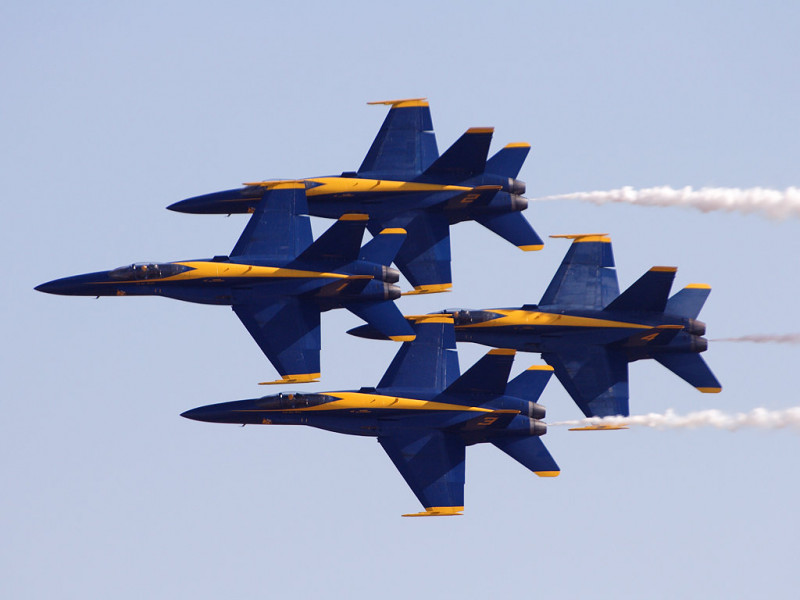The Blue Angels are the U.S. Navy's flight demonstration squadron, established in 1946. They are the second oldest aerobatic team globally. The team consists of six Navy and one Marine Corps demonstration pilots. They perform aerial displays using Boeing F/A-18E/F Super Hornets and Lockheed Martin C-130J Super Hercules aircraft.
1931: Formation of the Patrouille de France
In 1931, the Patrouille de France, the oldest formal aerobatic team in the world, was formed.
April 1946: Formation as Navy Flight Exhibition Team
In April 1946, the Blue Angels were originally formed as the Navy Flight Exhibition Team.
April 1946: Establishment of the Blue Angels
On 24 April 1946, the Blue Angels were established as a Navy flight exhibition team by order of Chief of Naval Operations Admiral Chester Nimitz to generate greater public support of naval aviation.
May 10, 1946: First Flight Demonstration of the Hellcat
On May 10, 1946, the Blue Angels, flying the F6F-5 Hellcat aircraft, made their first flight demonstration. The planes were painted in a dark navy blue with gold lettering.
May 1946: First Demonstration with Hellcat Aircraft
In May 1946, the Blue Angels held their first demonstration with the Grumman F6F-5 Hellcat aircraft before Navy officials, which was met with enthusiastic approval.
June 15, 1946: First Air Show Performance
On June 15, 1946, the United States Navy's Blue Angels performed their first air show at JaxEx (formerly Craig Municipal Airport) in Jacksonville, FL, flying three Gruman F6F Hellcat Fighter planes and employing a North American SNJ Texan, painted and configured to simulate a Japanese Zero.
July 1946: Introduction as The Blue Angels
During an air show in Omaha, Nebraska on July 19-21, 1946, the Navy Flight Exhibition Team was introduced as the Blue Angels.
August 1946: First Appearance of the Bearcat
In August 1946, the Bearcat made its first appearance when performing in Denver. It was the last propeller-driven aircraft flown by the Blue Angels and the first to fly the diamond formation.
August 1946: Transition to New Aircraft
In August 1946, the Blue Angels transitioned from the Grumman F6F-5 Hellcat to the Grumman F8F-1 Bearcat.
1946: Inaugural Season Practices and Techniques
In 1946, during their inaugural season, the Blue Angels employed many of the practices and techniques that they still use today.
1946: Formation of the Blue Angels
In 1946, the U.S. Navy Flight Demonstration Squadron, known as the Blue Angels, was formed. They are the second oldest formal aerobatic team in the world.
May 1947: Leadership Change and Relocation
In May 1947, Lt. Cmdr. Bob Clarke replaced Butch Voris as the leader of the Blue Angels team. The team, with an additional fifth pilot, relocated to Naval Air Station (NAS) Corpus Christi, Texas.
January 1948: Lt. Cmdr. Raleigh "Dusty" Rhodes Takes Command
In January 1948, Lt. Cmdr. Raleigh "Dusty" Rhodes took command of the Blue Angels team, flying four Bearcats and a yellow painted SNJ with USN markings dubbed "Beetle Bomb."
August 1949: Transition to Jet Aircraft
In August 1949, the Blue Angels transitioned from propeller-driven aircraft to blue and gold jet aircraft (Grumman F9F-2B Panther).
1949: All-Yellow Scheme
During the 1949 show season, the Blue Angels aircraft wore an all-yellow scheme with blue markings.
1949: Design of the Blue Angels Insignia
In 1949, Lt. Commander Raleigh "Dusty" Rhodes designed the original Blue Angels insignia or crest.
1951: Reactivation and Use of the Panther
In 1951, after a temporary disbandment for the Korean War, the Blue Angels were reactivated and again used the F9F-5 Panther.
1952: Leather Jackets and Colored Flight Suits
In 1952, the Blue Angels demonstration teams began wearing leather jackets and special colored flight suits with the Blue Angels insignia.
1953: Gold Colored Flight Suits
In 1953, the Blue Angels began wearing gold colored flight suits for the first show of the season and or to commemorate milestones for the flight demonstration squadron.
1954: Introduction of the Cougar
In the winter of 1954/55, the Blue Angels began flying the Cougar.
1957: Introduction of the Tiger
In mid 1957, the Blue Angels began flying the F11F-1 Tiger, which was the first supersonic jet and the last Grumman plane serving the flight team.
1957: Cougar Service Ends
In the middle of 1957, the Blue Angels stopped flying the Cougar.
1969: Introduction of the F-4J
In 1969, the F-4J became the demonstration plane for the Blue Angels.
December 1973: Reorganization as US Navy Flight Demonstration Squadron
On December 10, 1973, the Navy Flight Exhibition Team was reorganized and commissioned the United States Navy Flight Demonstration Squadron.
December 1974: Adoption of the A-4F Skyhawk II
In December 1974, the Blue Angels adopted the more economical A-4F Skyhawk II due to accidents and the price of fuel.
December 1974: End of the F-4J Era
In December 1974, the F-4J's service with the Blue Angels concluded.
1976: Bicentennial Celebrations and 2,000th Show
In 1976, the Blue Angels flew the A-4 in their 80 shows during the Bicentennial celebrations and also marked their 30th anniversary and performed their 2,000th show flying the A-4F Skyhawk II.
November 1986: End of Skyhawk Service
In November 1986, the A-4F Skyhawk II's service with the Blue Angels concluded.
1986: F/A-18 Hornet Transition
In 1986, the Blue Angels transitioned to flying the McDonnell Douglas F/A-18 Hornet, which they flew for 34 years.
1986: Transition to F/A-18 Hornet
In 1986, the Blue Angels transitioned to the F/A-18 Hornet aircraft.
2001: First Female Flight Surgeon
In 2001, Lt Tamara Schnurr became the first female Blue Angel flight surgeon.
2008: First Female Flight Officers
Since 2008, six female flight officers have been selected to serve with the Blue Angels.
2010: Transition to F/A-18C Hornet Model
In 2010, the Blue Angels transitioned to the F/A-18C model of the Hornet aircraft.
2011: Blue Angels funding
In 2011, the Blue Angels received $37 million from the annual Department of Defense budget.
March 2013: Cancellation of 2013 performances
In March 2013, the U.S. Navy announced the cancellation of the remaining 2013 Blue Angels performances after April 1, 2013, due to budget constraints.
April 2013: Cancellation of 2013 performances
In April 2013, the U.S. Navy cancelled the remaining 2013 Blue Angels performances due to budget constraints.
October 2013: Blue Angels performances to resume
In October 2013, Secretary of Defense Chuck Hagel announced that the Blue Angels, along with the U.S. Air Force's Thunderbirds, would resume appearing at air shows starting in 2014, though with a reduced number of flyovers.
2013: Only three air shows
In 2013, there were only three air shows due to budget constraints.
March 2014: Demonstration pilots wore gold flight suits
On 15 March 2014, the Blue Angels demonstration pilots numbered 1–7 wore gold flight suits to celebrate the team's "return to the skies" during their first air show of the season after only three air shows in 2013.
July 2014: Katie Higgins joins the Blue Angels
In July 2014, Marine Corps C-130 pilot Capt. Katie Higgins became the first female pilot to join the Blue Angels, flying the support aircraft Fat Albert for the 2015 and 2016 show seasons.
2014: Blue Angels performances to resume
Starting in 2014, the Blue Angels resumed appearing at air shows after the cancellation of performances in 2013 due to budget constraints. However, the number of flyovers was reduced.
July 2015: Bob Flynn becomes executive officer
In July 2015, Cmdr. Bob Flynn became the Blue Angels' first executive officer.
2015: Katie Higgins pilots Fat Albert
In 2015, Capt. Katie Higgins flew the support aircraft Fat Albert for the Blue Angels show season.
June 2016: Death of Capt. Jeff Kuss
On 2 June 2016, Capt. Jeff Kuss died just after takeoff while performing the Split-S maneuver in his Hornet during a practice run for The Great Tennessee Air Show in Smyrna, Tennessee.
July 2016: Boeing awarded contract
In July 2016, Boeing was awarded a $12 million contract to begin an engineering proposal for converting the Boeing F/A-18E/F Super Hornet for Blue Angels use, with the proposal to be completed by September 2017.
2016: Katie Higgins pilots Fat Albert
In 2016, Capt. Katie Higgins flew the support aircraft Fat Albert for the Blue Angels show season.
September 2017: Engineering proposal completion
By September 2017, Boeing was to complete the engineering proposal for converting the Boeing F/A-18E/F Super Hornet for Blue Angels use, as part of a contract awarded in July 2016.
2017: Cmdr. Frank Weisser finishes season
In 2017, Cmdr. Frank Weisser finished out the season after replacing Capt. Jeff Kuss.
August 2018: Boeing contract for Super Hornet conversion
In August 2018, Boeing was awarded a contract to convert nine single-seat F/A-18E and two F/A-18F Super Hornets for Blue Angels use, including modifications like smoke-oil tanks and tensioned control sticks.
May 2019: Retirement of Fat Albert
In May 2019, the Fat Albert (BUNO 164763) was retired from service with 30,000 flight hours. The Blue Angels replaced it with a C-130J Super Hercules acquired from the Royal Air Force (BUNO 170000).
November 2020: Transition to Super Hornets
On 4 November 2020, the Blue Angels officially transitioned to Boeing F/A-18E/F Super Hornets.
2020: Number of Demonstration Pilots
As of the 2020 season, there have been 272 demonstration pilots in the Blue Angels since their inception.
2020: End of Hornet Era
In 2020, the Blue Angels concluded their 34-year use of the McDonnell Douglas F/A-18 Hornet, and transitioned to the Boeing F/A-18 Super Hornet.
2020: Purchase of RAF Lockheed C-130J Super Hercules
In 2020, the United States Marine Corps Blue Angels purchased a surplus Royal Air Force Lockheed C-130J Super Hercules, registered as ZH885, for logistics and support as the new "Fat Albert".
2020: Testing of converted aircraft
In mid-2020, the converted F/A-18E/F Super Hornets were delivered and used for testing maneuvers.
2021: Super Hornets become operational
By the beginning of 2021, the Blue Angels' Super Hornets became operational, coinciding with their 75th anniversary year.
July 2022: Amanda Lee announced as demonstration pilot
In July 2022, Lt. Amanda Lee was announced as the first woman to serve as a demonstration pilot in the Blue Angels.
2022: First Woman F/A-18 Demonstration Pilot
From 2022 to 2024, LCDR Amanda Lee served as the first woman to be named as a F/A-18 demonstration pilot with the Blue Angels.
2024: End of First Woman F/A-18 Demonstration Pilot
From 2022 to 2024, LCDR Amanda Lee served as the first woman to be named as a F/A-18 demonstration pilot with the Blue Angels.
2025: LCDR Lilly Montana as Events Coordinator
In 2025, LCDR Lilly Montana is serving as Events Coordinator for the Blue Angels.
2025: 2025 United States Navy Blue Angels Demonstration Pilots and Flight Officers
In 2025, the United States Navy Blue Angels will have demonstration pilots and flight officers.
2025: Navy Member as Maintenance Officer
Now in 2025 one Navy Member serves two years as the Maintenance Officer.
Mentioned in this timeline
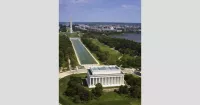
Washington D C is the capital city and federal district...
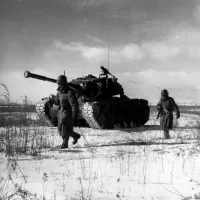
The Korean War - was a conflict between North Korea...
Japan is an East Asian island country situated in the...
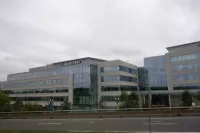
The Boeing Company is a multinational corporation and one of...
Korea is a peninsular region in East Asia comprised of...
Florida a state in the Southeastern United States is largely...
Trending
1 month ago Omarion Hampton, Derwin James, Tarheeb Still face injuries: Updates and impact on teams.

4 months ago Corey Lewandowski's DHS Power Grows Amidst Affair Rumors with Kristi Noem.

7 days ago Alina Habba Disqualified: Court Rules Against Former Trump Lawyer in New Jersey Role

Kris Boyd is a Scottish former professional footballer who played as a forward He is now working as a sports...

6 months ago Whoopi Goldberg sparks controversy on 'The View,' comparing US to Iran in heated debate.
7 months ago Dengue outbreak in Cook Islands prompts agency response and community clean-ups.
Popular
Matt and Ross Duffer known as the Duffer Brothers are...
Aftyn Alyssa Behn is an American politician currently serving as...

Candace Owens is an American conservative political commentator and author...

Ilhan Omar is an American politician currently serving as the...

XXXTentacion born Jahseh Dwayne Ricardo Onfroy was a controversial yet...
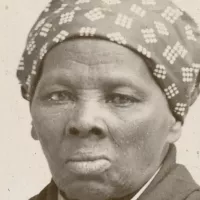
Harriet Tubman was a pivotal American abolitionist and social activist...
